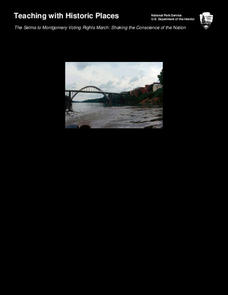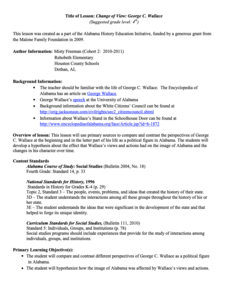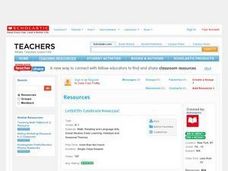John F. Kennedy Center
Musical Harlem: How Is Jazz Music Reflective of the Harlem Renaissance?
Bring jazz music and the Harlem Renaissance to light with a lesson that challenges scholars to research and create. Pupils delve deep into information materials to identify jazz terminology, compare types of jazz and jazz musicians,...
Core Knowledge Foundation
Ray Charles
Introduce young learners to the read-aloud process with a short biographical passage about Ray Charles. After listening to the passage, class members respond to factual, inferential, and evaluative questions, and then create a timeline...
Look! We're Learning!
Ella Fitzgerald Biography Mini-Unit
Before there was Beyonce, before there was Madonna, before there was Cher, there was Ella. Introduce Ella Fitzgerald, The First Lady of Jazz, with a reading comprehension exercise that presents a brief biography of her life and then asks...
Historic New Orleans Collection
Exploring Primary Sources: Music in New Orleans
Looking for a new and exciting way to teach young historians the art of primary source analysis? Jazz up your lesson plan with a resource that asks class members to analyze photos, travel documents, and letters written by some of New...
Education World
Remembering Jackie Robinson
A four-paragraph informational text details the life of the famous baseball player, Jackie Robinson. A prompt challenges scholars to write or discuss a time in their life when they were not included and how that made them feel.
National Endowment for the Humanities
Hopi Place Names
What's in a name? Historians consider the question as they examine places important to the Hopi people and the meanings of their place names. Included worksheets include maps and charts to help class members examine the geography of Hopi...
DocsTeach
Confronting Work Place Discrimination on the World War II Home Front
Before the Civil Rights Movement was in full swing, FDR's executive order helped promote fair employment. The activity uses primary documents to explore FDR's executive order to help minorities gain equal employment and pay during the...
National Park Service
The Selma to Montgomery Voting Rights March: Shaking the Conscience of the Nation
Travel back in time to examine how tragic events can spur positive change. Scholars explore the impact of the Selma Voting Rights March, including the tragic loss of life and the later signing of the Voting Rights Act of 1965. Academics...
National Park Service
Remembering Pearl Harbor: The USS Arizona Memorial
Young historians use primary source materials to investigate the 1941 attack on Pearl Harbor and the sinking of the USS Arizona. After reading background articles and studying maps and images of the attack, class members consider whether...
Alabama Department of Archives and History
Change of View: George C. Wallace
Who exactly was George C. Wallace? A great lesson plan provides young historians with a hands-on activity, direct instruction, and discussion to learn about Wallace, why he was an important figure, and why he changed his mind about...
Oklahoma City of Museum Art
Harlem Renaissance
Individuals expressed the Harlem Renaissance in diverse forms of art, ranging from poetry to photography to painting. Learners explore pieces using a carefully curated collection from the Oklahoma City Museum of Art. Included lessons ask...
Teaching Tolerance
Introducing 'The New Jim Crow'
When Jim Crow Laws ended, the intent behind them did not. Academics read "The New Jim Crow Laws" and an interview from the author to understand how racism has not ended, but rather changed over time. The lesson explains how prejudices in...
Voices of a People's History
Voices in The Classroom
Everyone's perspective of the past is different. A thought-provoking unit gives young academics the opportunity to explore their perspectives on history and their neighborhoods. Based on the work of Howard Zinn, each lesson explores...
Teaching Tolerance
Voting in Your Town
A socially important resource focuses on voter turnout and roadblocks to voting. Scholars review resources on voting stats, watch a documentary, and participate in group discussion regarding voting in their local communities. Academics...
Smithsonian Institution
A Dream Deferred: DACA
"Give us your tired, your poor, your huddled masses" has even more meaning for some children. The resource explores the Deferred Action for Childhood Arrivals (DACA) program. Scholars analyze primary sources and participate in...
Curated OER
Let's Celebrate Kwanzaa!
Learn more about Kwanzaa with a celebratory lesson. As learners analyze My First Kwanzaa Book by Debbi Chocolate, they compare and contrast the celebration to other holiday traditions they know about. Next, they prepare and...
Curated OER
Unity in Action
Elementary learners make a collage after learning about Kwanzaa. They discuss the concept of unity and make a collage of pictures that they feel exemplify unity.
What So Proudly We Hail
The Meaning of America: Freedom and Religion
The United States of America was founded on firm ideals of both the pursuit of happiness and a spirit of reverence. Through a close reading of Nathaniel Hawthorne's "The May-Pole of Merry Mount," you can examine what some consider was a...
Curated OER
Native Americans
Students, in groups, research various Native American tribes. They wirte a report about the tribe which includes information about their food and ceremonies, among other things. They create a diorama and a poster that shows how they...
Curated OER
Trips of Culture: The Statue of Liberty
Learners take a pre-trip quiz about the Statue of Liberty and take a photo tour on the Internet. They then produce a grid drawing of an object and use a known measurement to estimate unknown measurements.
Curated OER
What's Old Is New Again
Students explore cultural trends in the United States in the 20th century and examine the resurgence of some of those trends in today's society.
Curated OER
The Great Seal
Students study patriotic symbols of America. In this American history lesson, students construct a KWL chart on United States symbols and examine visuals of the Great Seal and bald eagle. Students create another symbol for America.
Curated OER
American Colonial Life in the Late 1700s: Distant Cousins
Students research how early colonists lived. They investigate late 17th century colonist's lives from Massachusetts and Delaware. Using their research, students write historical fiction in the form of friendly letters between the two...
Curated OER
Sitting Bull: Chief of the Lakota Nation
Learners view the "Sitting Bull" video, complete vocabulary work, and discuss the video as a class.























